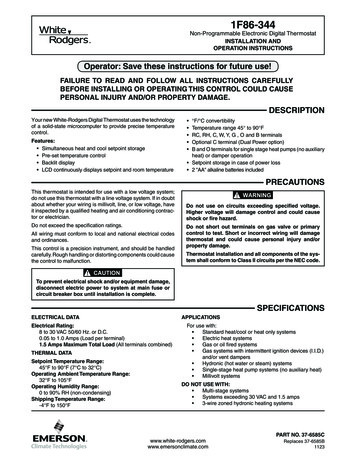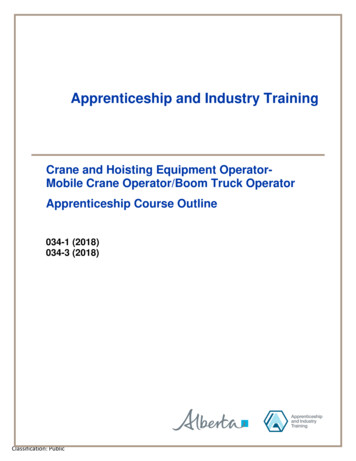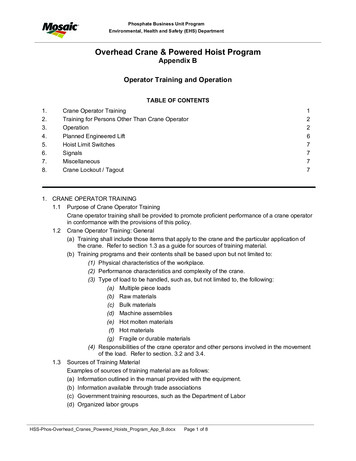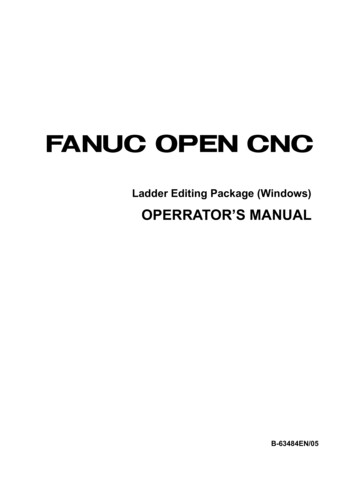
Transcription
1F86-344Non-Programmable Electronic Digital ThermostatINSTALLATION ANDOPERATION INSTRUCTIONSOperator: Save these instructions for future use!FAILURE TO READ AND FOLLOW ALL INSTRUCTIONS CAREFULLYBEFORE INSTALLING OR OPERATING THIS CONTROL COULD CAUSEPERSONAL INJURY AND/OR PROPERTY DAMAGE.DESCRIPTIONYour new White-Rodgers Digital Thermostat uses the technologyof a solid-state microcomputer to provide precise temperaturecontrol.Features: Simultaneous heat and cool setpoint storage Pre-set temperature control Backlit display LCD continuously displays setpoint and room temperature F/ C convertibilityTemperature range 45 to 90 FRC, RH, C, W, Y, G , O and B terminalsOptional C terminal (Dual Power option)B and O terminals for single stage heat pumps (no auxiliaryheat) or damper operation Setpoint storage in case of power loss 2 "AA" alkaline batteries includedPRECAUTIONSThis thermostat is intended for use with a low voltage system;do not use this thermostat with a line voltage system. If in doubtabout whether your wiring is millivolt, line, or low voltage, haveit inspected by a qualified heating and air conditioning contractor or electrician.Do not exceed the specification ratings.All wiring must conform to local and national electrical codesand ordinances.This control is a precision instrument, and should be handledcarefully. Rough handling or distorting components could causethe control to malfunction.! WARNINGDo not use on circuits exceeding specified voltage.Higher voltage will damage control and could causeshock or fire hazard.Do not short out terminals on gas valve or primarycontrol to test. Short or incorrect wiring will damagethermostat and could cause personal injury and/orproperty damage.Thermostat installation and all components of the system shall conform to Class II circuits per the NEC code.! CAUTIONTo prevent electrical shock and/or equipment damage,disconnect electric power to system at main fuse orcircuit breaker box until installation is complete.SPECIFICATIONSELECTRICAL DATAAPPLICATIONSElectrical Rating:8 to 30 VAC 50/60 Hz. or D.C.0.05 to 1.0 Amps (Load per terminal)1.5 Amps Maximum Total Load (All terminals combined)THERMAL DATASetpoint Temperature Range:45 F to 90 F (7 C to 32 C)Operating Ambient Temperature Range:32 F to 105 FOperating Humidity Range:0 to 90% RH (non-condensing)Shipping Temperature Range:-4 F to 150 FFor use with: Standard heat/cool or heat only systems Electric heat systems Gas or oil fired systems Gas systems with intermittent ignition devices (I.I.D.)and/or vent dampers Hydronic (hot water or steam) systems Single-stage heat pump systems (no auxiliary heat) Millivolt systemsDO NOT USE WITH: Multi-stage systems Systems exceeding 30 VAC and 1.5 amps 3-wire zoned hydronic heating PART NO. 37-6585CReplaces 37-6585B1123
INSTALLATIONREMOVE OLD THERMOSTATScrew anchors1. Shut off electricity at the main fuse box until installation iscomplete. Ensure that electrical power is disconnected.2. Remove the front cover of the old thermostat. With wiresstill attached, remove wall plate from the wall. If the oldthermostat has a wall mounting plate, remove the thermostatand the wall mounting plate as an assembly.3. Identify each wire attached to the old thermostat usingthe labels enclosed with the new thermostat.4. Disconnect the wires from old thermostat one at a time. DONOT LET WIRES FALL BACK INTO THE WALL.5. Install new thermostat using the following procedures.MountingholesATTENTION!This product does not contain mercury. However, this productmay replace a unit which contains mercury.Electric/GasswitchDo not open mercury cells. If a cell becomes damaged, do nottouch any spilled mercury. Wearing nonabsorbent gloves, takeup the spilled mercury with sand or other absorbent material andplace into a container which can be sealed. If a cell becomesdamaged, the unit should be discarded.MountingholesFigure 1. Thermostat Base6. Push excess wire into wall and plug hole with a fire-resistantmaterial (such as fiberglass insulation) to prevent drafts fromaffecting thermostat operation.Mercury must not be discarded in household trash. When theunit this product is replacing is to be discarded, place in a suitable container. Refer to www.white-rodgers.com for location tosend product containing mercury.BATTERY LOCATION2 "AA" alkaline batteries are included in the thermostat at thefactory with a battery tag to prevent power drainage. You mustremove the battery tag to engage the batteries.ELECTRIC HEAT OR SINGLE-STAGEHEAT PUMP SYSTEMSIf "LO BATTERY" is displayed, the batteries are low and shouldbe replaced. For best results, replace all batteries with new premium brand alkaline batteries such as Duracell or Energizer .To replace batteries, install the batteries along the top of thebase (see Fig. 1). The batteries must be installed with the positive ( ) end to the left.This thermostat is configured from the factory to operate a heat/cool, fossil fuel (gas, oil, etc.), forced air system. It is configuredcorrectly for any system that DOES NOT require the thermostatto energize the fan on a call for heat. If your system is an electricheat or heat-pump system that REQUIRES the thermostat toturn on the fan on a call for heat, locate the GAS/ELECTRICswitch on the back of the thermostat (see fig. 1) and switch it tothe ELECTRIC position.This will allow the thermostat to energizethe fan immediately on a call for heat. If you are unsure if theheating/cooling system requires the thermostat to control the fan,contact a qualified heating and air conditioning service person.HYDRONIC (HOT WATER OR STEAM)HEATING SYSTEMSThis thermostat is set to operate properly with a forced-air heating system. If you have a hydronic heating system (a systemthat heats with hot water or steam), you must set the thermostatto operate properly with your system. Change the second option in the configuration menu to SL (see CONFIGURATIONMENU, page 4).ATTACH THERMOSTAT BASE TO WALL1. Remove the packing material from the thermostat. Gently pull thecover straight off the base. Forcing or prying on the thermostatwill cause damage to the unit. If necessary, move the electricheat switch (see ELECTRIC HEAT SYSTEMS, above).2. Connect wires beneath terminal screws on base using appropriate wiring schematic (see figs. 2 through 7).3. Place base over hole in wall and mark mounting hole locations on wall using base as a template.4. Move base out of the way. Drill mounting holes.5. Fasten base loosely to wall, as shown in fig. 1, using twomounting screws. Place a level against bottom of base,adjust until level, and then tighten screws. (Leveling is forappearance only and will not affect thermostat operation.)If you are using existing mounting holes, or if holes drilledare too large and do not allow you to tighten base snugly,use plastic screw anchors to secure subbase.CHECK THERMOSTAT OPERATIONIf at any time during testing your system does not operateproperly, contact a qualified service person.Turn on power to the system.Fan OperationIf your system does not have a G terminal connection, skip toHeating System.1. Move FAN switch to ON position. The blower should beginto operate.2. Move FAN switch to AUTO position. The blower should stopimmediately.2
ngSystemORC24 VACHotNeutralHEATINGTRANSFORMER120 VACHotTRANSFORMER24 VACFigure 2. Typical wiring diagram forheat only, 3-wire, single transformer systemsOYGCoolingSystemFanRelayWRCRH120 VACNeutralCOOLING TRANSFORMERFigure 5. Typical wiring diagram forheat/cool, 5-wire, two-transformer systemsJUMPERWIREB120 VACNeutralFor 2-wire Heat only,attach to RH and WC‡SYSTEM24 t24 VACC‡BYOJUMPERWIREGWRCTHERMOSTATRHSYSTEM120 VACNeutralReversing Compressor FanValve*Contactor RelayTRANSFORMERFigure 3. Typical wiring diagram forcool only, 3-wire, single transformer systemsHot24 VAC* Reversing valve is energized when thesystem switch is in the COOL position120 VACNeutralTRANSFORMERFigure 6. Typical wiring diagram for heat pumpwith reversing valve energized in COOLNOTERED jumper wire (provided with thermostat) must beconnected between thermostat RH and RC terminalsfor proper thermostat operation with this 20 VACRH* Reversing valve is energized when thesystem switch is in the HEAT positionTRANSFORMERTHERMOSTATSYSTEMHot24 VACNeutral120 VACNeutralTRANSFORMERFigure 7. Typical wiring diagram for heat pumpwith reversing valve energized in HEATFigure 4. Typical wiring diagram forheat/cool, 4-wire, single transformer systems‡OReversing Compressor FanValve*Contactor RelayHot24 VACBJUMPERWIREThe 24 Volt neutral connection to terminal C on the thermostat is not required if the batteries are replaced once ayear with fresh premium brand alkaline batteries.Heating SystemCooling System1. Move SYSTEM switch to HEAT position. If the heating systemhas a standing pilot, be sure to light it.! CAUTIONTo prevent compressor and/or property damage, if theoutdoor temperature is below 50 F, DO NOT operatethe cooling system.2. Pressto adjust thermostat setting above room temperature. The heating system should begin to operate.3. Pressto adjust temperature setting below room temperature. The heating system should stop operating.1. Move SYSTEM switch to COOL position.2. Pressto adjust thermostat setting below room temperature. The blower should come on immediately on high speed,followed by cold air circulation.3. Pressto adjust temperature setting above room temperature. The cooling system should stop operating.3
OPERATIONBefore you begin using your thermostat, you should be familiarwith its features and with the display and the location and operation of the thermostat buttons. Your thermostat consists oftwo parts: the thermostat cover and the base. To remove thecover, pull it straight out from the base. To replace the cover,line up the cover with the base and press until the cover snapsonto the base.The Thermostat Buttons and Switches(see fig. 8)1 Raises temperature setting.2 Lowers temperature setting.3 FAN switch (ON, AUTO).4 SYSTEM switch (COOL, OFF, HEAT).FThe DisplayCBATTERY5 Flame icon ( ) is displayed when the SYSTEM switchis in the HEAT position. Snowflake icon ( )is displayed(non-flashing) when the SYSTEM switch is in the COOLposition. Snowflake is displayed (flashing) if the thermostatis in lockout mode to prevent the compressor from cyclingtoo quickly.9FILTER85765Figure 8. Thermostat display, buttons, and switchesCONFIGURATION MENU6 Displays current temperature.The configuration menu allows you to set certain thermostat operating characteristics to your system or personal requirements.7 Displays "FILTER" when the system has run for the selectedfilter time period as a reminder to change or clean your airfilter.Move SYSTEM switch to the OFF position, then pressandat the same time to enter the configuration menu.The displaywill show the first item in the configuration menu.8 Displays set point temperature (this is blank when SYSTEMswitch is in the OFF position).The configuration menu chart below summarizes the configuration options. An explanation of each option follows.9 Displays "BATTERY" and "LO" in the current temperaturelocation when the 2 "AA" batteries are low and should bereplaced.Pressandto change to the next menu item. To exit themenu, move the SYSTEM switch to HEAT or COOL. If no keysare pressed within fifteen minutes, the thermostat will exit theconfiguration menu.Configuration MenuStepPress Button(s)1Set SYSTEMswitch to OFF2Displayed (Factory Default) Pressorto select:SYSTEM switch must be OFF to configure thermostatoptionsSLandCOMMENTSSelect FA or SL (Fast or Slow) heating cycle rate(FA)3andd-L(ON)OFFSelect display backlight OFF or ON4andFILTER(000)0 to 1950 hours(in 50 hour increments)Select Filter replacement run time5andLOC(OFF)ON6and0 HI(0)4 LO to4 HI7and(F)C8Set SYSTEMswitch to HEATor COOL* PressandSelect Compressor lockout OFF or ONSelect temperature display adjustment higher or lowerSelect temperature display to F or CReturns to normal operationto advance to next item4
OPERATIONSETTING THE THERMOSTAT2) Select FA or SL (Fast or Slow) Heating Cycle Rate - TheFA setting is frequently used for gas, oil or electric heat. TheSL setting produces a longer heating cycle which is normallyfor hot water or steam (hydronic) systems. Both settingsproduce very accurate temperature control and can be setto your personal preference. FA cycles the system just under1 F and the SL setting cycles at approximately 1.5 F.3) Select Display Backlight (d-L OFF or ON) - The displaybacklight improves display contrast in low lighting conditions.Selecting backlight ON will keep the light on for a short periodof time after any key is pressed. Selecting OFF will keep thelight off.4) Select filter replacement run time - The thermostat willdisplay "FILTER" after the selected time of operation. This isa reminder to change or clean your air filter. This time can beset from 0 to 1950 hours in 50 hour increments. A selectionof 000 will cancel this feature. When "FILTER" is displayed,This thermostat is very easy to operate. Set the SYSTEMswitch to either HEAT or COOL then pressoruntil thetemperature you want to maintain is shown on the right sideof the display. If you want to turn the system off, just move theSYSTEM switch to OFF.The FAN switch controls the fan operation. When the FANswitch is set to AUTO, the fan will cycle with the furnace or airconditioner. When the FAN switch is set to ON, the fan will runcontinuously, regardless of SYSTEM switch position.TROUBLESHOOTINGNo HeatingWith the SYSTEM switch set to HEAT, when the setpointtemperature is raised or lowered past the room temperature,the thermostat will make a soft click sound. Usually, the soundindicates the thermostat is operating correctly. If the systemdoes not come on, check the system or contact your heating/cooling service person. If the thermostat does not click try theReset Operation listed below.you can clear it by pressingandat the same time.This resets the timer and starts counting the hours until thenext filter change.5) Select Compressor Lockout (LOC OFF or ON) - SelectingLOC ON will cause the thermostat to wait 5 minutes beforeturning on the compressor if the heating and cooling systemloses power. It will also wait 5 minutes minimum betweencooling cycles. This is intended to help protect the compressor from short cycling. Some newer compressors alreadyhave a time delay built in and do not require this feature.Your compressor manufacturer can tell you if the feature isalready present in their system. When the compressor timedelay occurs it will flash the (snowflake icon) for about fiveminutes then turn on the compressor.6) Select Temperature Display Adjustment (4 LO to 4HI) - Allows you to adjust the room temperature display 4 higher or lower. Your thermostat was accurately calibratedat the factory but you have the option to change the displaytemperature to match your previous thermostat.7) SelectTemperature DIsplay ( F or C) - Changes the displayreadout to Celsius or Fahrenheit as required.No CoolingSame procedure as heating except set SYSTEM switch to COOL.There can be up to a 5 minute compressor lock-out time delaybefore the thermostat clicks in COOL.Blank DisplayA blank digital display usually indicates the thermostat hasreceived a voltage spike, static discharge or requires new batteries. If the display remains blank after replacing the batteries,see Reset Operation below.Reset OperationIf a voltage spike or static discharge blanks out the display orcauses erratic thermostat operation you can reset the thermostatby pressing,and move the SYSTEM switch from OFF toHEAT at the same time. This also resets the factory defaultsto the configuration menu. If the thermostat has power, hasbeen reset and still does not function correctly contact yourheating/cooling service person or place of purchase.OPERATING FEATURESNow that you are familiar with the thermostat buttons and display,read the following information to learn about the many featuresof the thermostat. SIMULTANEOUS HEATING/COOLING SETPOINT STORAGE — You can enter both your heating and cooling setpoints at the same time. There is no need to change thethermostat at the beginning of each season. CONFIGURATION MENU — Allows you to customizecertain thermostat options.5
Homeowner Help Line: 1-800-284-2925White-Rodgers is a divisionof Emerson Electric Co.The Emerson logo is atrademark and service markof Emerson Electric Co.www.white-rodgers.comwww.emersonclimate.com
LÍNEA DE AYUDA PARA EL USUARIO: 1-800-284-2925White-Rodgers es una divisiónde Emerson Electric Co.El logotipo de Emerson es unamarca comercial y una marcade servicio de Emerson Electric Co.www.white-rodgers.comwww.emersonclimate.com
2)3)4)5)6)Seleccione Display Backlight (luz de fondo de pantalla) (d-LOFF [desactivada] u ON [activada]) - La luz de fondo mejora elcontraste de la pantalla en condiciones de poca luz. Si seleccionabacklight ON, la luz se mantendrá encendida durante un brevetiempo después de presionar cualquier botón. Si selecciona OFF,la luz se mantendrá apagada.Seleccione filter replacement run time (tiempo de ejecución dereemplazo de filtro) - El termostato mostrará “FILTER” despuésdel tiempo de funcionamiento seleccionado. El propósito de estemensaje es recordarle que cambie o limpie el filtro de aire. El tiempopuede ajustarse desde 0 hasta 1950 horas en incrementos de 50horas. Si elige 000, se cancelará esta función. Cuando apareceyal mismo tiempo.“FILTER”, puede borrarlo presionandoDe esta manera volverá a cero el reloj y se comenzarán a contarlas horas que faltan hasta el siguiente cambio de filtro.Seleccione Compressor Lockout (bloqueo del compresor) (LOCOFF [desactivado] u ON [activado]) Si selecciona LOC ON eltermostato esperará 5 minutos para encender el compresor si elsistema de calefacción y refrigeración deja de recibir alimentacióneléctrica. También esperará 5 minutos como mínimo entre ciclosde refrigeración para evitar que el compresor realice ciclos deencendido y apagado cortos. Algunos compresores más nuevosya tienen incorporada una demora de tiempo y no requieren estafunción. Consulte al fabricante de su compresor para saber si sumodelo incluye con esta función. Cuando se produce la demorade tiempo del compresor, el (icono del copo de nieve) se poneen intermitente durante unos cinco minutos y luego enciende elcompresor.Seleccione Temperature Display Adjustment (ajuste de lapantalla de temperatura) (4 LO [más abajo] a 4 HI [más arriba]) Le permite ajustar la pantalla de temperatura ambiente 4 más arribao más abajo. El termostato viene calibrado con precisión de fábricapero usted tiene la opción de cambiar el valor de temperatura queaparece en la pantalla para que coincida con el de su termostatoanterior.SeleccioneTemperature Display (visualización de temperatura)(F o C ) - Cambia la unidad en que aparece la temperatura en lapantalla a grados Celsius o Fahrenheit según su preferencia.FUNCIONES DEL TERMOSTATOAhora que está familiarizado con los botones del termostato y lapantalla, lea la siguiente información para conocer las diferentesfunciones del termostato. ALMACENAMIENTO SIMULTÁNEO DE TEMPERATURASDE REFERENCIA DE CALEFACCIÓN/REFRIGERACIÓN —Puede ingresar sus temperaturas de referencia de calefaccióny refrigeración al mismo tiempo. No es necesario realizarmodificaciones en el termostato al comienzo de cada estación. MENÚ DE CONFIGURACIÓN — Le permite personalizar ciertasopciones del termostato.OPERACIÓNAJUSTE DEL TERMOSTATOEste termostato es muy sencillo de operar. Ajuste el interruptor SYSTEMen HEAT o COOL y luego presioneohasta que la temperaturaque desea mantener aparezca a la derecha de la pantalla. Si deseaapagar el sistema, simplemente mueva el interruptor SYSTEM a laposición OFF.El interruptor FAN controla el funcionamiento del ventilador. Cuando elinterruptor FAN se coloca en AUTO, el ventilador se encenderá y seapagará con la caldera o el aire acondicionado. Cuando el interruptor FANestá ajustado en ON, el ventilador funcionará de manera ininterrumpida,independientemente de la posición del interruptor SYSTEM.SOLUCIÓN DE PROBLEMASEl sistema no calientaCon el interruptor SYSTEM ajustado en HEAT, cuando la temperaturade referencia se sube o se baja por encima o debajo de la temperaturaambiente, el termostato emitirá un chasquido suave. Por lo general, elsonido indica que el termostato está funcionando correctamente. Si elsistema no se enciende, verifique el sistema o póngase en contactocon su servicio técnico de calefacción/refrigeración. Si el termostatono emite un chasquido, siga el procedimiento indicado en la secciónOperación de reajuste a continuación.El sistema no enfríaSiga el mismo procedimiento que para calefacción colocando elinterruptor SYSTEM en COOL. Es posible que haya una demora delbloqueo del compresor de hasta 5 minutos antes de que el termostatose active en COOL.La pantalla está en blancoPor lo general, una pantalla digital en blanco indica que eltermostato ha recibido un pico de voltaje o una descarga estáticao que es necesario cambiar las pilas. Si la pantalla permaneceen blanco después de cambiar las pilas, vea la secciónOperación de reajuste a continuación.Operación de reajusteSi un pico de voltaje o una descarga estática pone en blanco lapantalla o hace que el termostato funcione de manera errática,yy moviendo elpuede reajustarlo presionandointerruptor SYSTEM de OFF a HEAT al mismo tiempo. De estamanera, también reajustará los valores predeterminados defábrica según el menú de configuración. Si el termostato tienealimentación y se ha reajustado pero aún no funciona correctamente,póngase en contacto con su servicio técnico de calefacción/refrigeracióno con el lugar donde realizó la compra.5
OPERACIÓNAntes de que comience a usar su termostato, debe familiarizarse consus funciones y con la pantalla y la ubicación y funcionamiento de losdiferentes botones. Su termostato consta de dos partes: la cubierta deltermostato y la base. Para retirar la cubierta, tire suavemente de ellapara separarla de la base. Para volver a colocarla, alinee la cubiertacon la base y presione suavemente hasta que se enganche en la base.Los botones e interruptores del termostato(vea la figura 8)1 Sube el ajuste de temperatura.2 Baja el ajuste de temperatura.3 Interruptor FAN (ventilador) (ON, AUTO).4 Interruptor SYSTEM (COOL, OFF, HEAT).La pantalla5 El icono de la llama ( ) aparece cuando el interruptorSYSTEM está en la posición HEAT. El icono del copo denieve ( ) aparece (fijo) cuando el interruptor SYSTEMestá en la posición COOL. El copo de nieve aparece(intermitente) cuando el termostato está en el modo de bloqueopara evitar que el compresor realice ciclos de encendido y apagadodemasiado cortos.6 Muestra la temperatura actual.7 Muestra "FILTER" cuando el sistema se ha utilizado por lacantidad de tiempo seleccionada en el filtro para recordarle quedebe cambiar o limpiar el filtro de aire.8 Muestra la temperatura de referencia (aparece en blanco cuandoel interruptor SYSTEM está en la posición OFF).9 Muestra "BATTERY" y "LO" en lugar de la temperaturacuando las 2 pilas “AA” tienen poca carga y debencambiarse.MENÚ DE CONFIGURACIÓNEl menú de configuración le permite ajustar ciertas característicasoperativas del termostato según el sistema o sus a 8. Pantalla, botones e interruptores del termostatoEn el cuadro del menú de configuración a continuación se resumenlas diferentes opciones de configuración disponibles, seguidas por unaexplicación de cada una.ypara pasar a la siguiente opción del menú. ParaPresionesalir del menú, mueva el interruptor SYSTEM a HEAT o COOL. Sipasan quince minutos sin presionar ningún botón, el termostato saldrádel menú de configuración.1) Seleccione FA o SL (rápida o lenta) para Heating Cycle Rate(velocidad del ciclo de calefacción) - La configuración FA sueleutilizarse para sistemas de calefacción de gas, aceite o eléctricos. Laconfiguración SL produce un ciclo de calefacción más largo que lonormal para sistemas de agua caliente o vapor (hidrónicos). Ambasconfiguraciones producen un control de temperatura sumamenteexacto y pueden ajustarse según su preferencia personal. Laconfiguración FA apaga y enciende el sistema debajo de 1 F y laconfiguración SL lo hace a aproximadamente 1.5 F.Mueva el interruptor SYSTEM a la posición OFF y luego presioneal mismo tiempo para ingresar en el menú de configuración. Lapantalla mostrará la primera opción del menú de configuración.yMenú de configuraciónPaso12345678* PresionePresione el botóno botonesLa pantalla muestra(ajustado de fábrica)Presioneopara seleccionar:OBSERVACIONESEl interruptor SYSTEM debe estar en OFF para configurarlas opciones del termostatoAjuste el interruptorSYSTEM en OFFSelecciona FA o SL (rápida o lenta) para la velocidaddel ciclo de calefacciónSLy(FA)( F)y4 LO a4 HI0 HI(0)yONLOC(OFF)yFILTER(000)yd-L(ON)yOFFSelecciona luz de fondo de pantalla OFF (apagada) uON (encendida)0 a 1950 horasSelecciona el tiempo de ejecución de reemplazo del filtro(en incrementos de 50 horas)Selecciona el bloqueo del compresor en OFF (desactivado) uON (activado)Selecciona el ajuste de la temperatura visualizada másarriba o más abajoSelecciona la visualización de la temperatura en F o C CVuelve al funcionamiento normalAjuste elinterruptor SYSTEMen HEAT o COOLypara pasar a la siguiente opción del menú.4
C‡BOYGRelédelventiladorWCABLEDE n ventilador calefacciónTERMOSTATO24 VACVCABWRCRHRHSISTEMAVivoVivoNeutroG120 VCAVACNeutro120 VACVCA24 VACVCATRANSFORMADORYOTERMOSTATO24 VACVCATRANSFORMADORDE CALEFACCIÓNVivoNOTAPara sólo calor con 2 cables,conectar a RH y WFigura 2. Diagrama de conexiones típico para sistemasde sólo calor de un solo transformador y 3 cablesCABLEDE PUENTEC‡SistemaRelédedelrefrigeración ventilador120 VCANeutroTRANSFORMADOR DE REFRIGERACIÓNFigura 5. Diagrama de conexiones típico para sistemasde calor/frío de dos transformadores y 5 cablesSISTEMATERMOSTATOCABLEDE PUENTEC‡Vivo24 VACVCA120 VCABNeutroYOVálvulainversora*TRANSFORMADORFigura 3. Diagrama de conexiones típico para sistemasde sólo frío de un solo transformador y 3 cablesGContactordelcompresorCABLEDE 24 VCA* La válvula inversora se energiza cuando elinterruptor del sistema está en la posición COOL120 VCANeutroTRANSFORMADORFigura 6. Diagrama de conexiones típico para una bombade calor con válvula inversora energizada en COOLNOTAEl cable de puente ROJO (suministrado con el termostato) debeconectarse entre las terminales RH y RC del termostato para queCABLEfuncione en forma adecuada con este sistema.DE PUENTEC‡BYOGWSistemaRelédedelrefrigeración ventiladorRCRHCABLEDE Válvulainversora*VivoVCA24 VAC120 VACVCAYGContactordelcompresorCABLEDE 24 VCA* La válvula inversora se energiza cuando elinterruptor del sistema está en la posición HEATNeutroTRANSFORMADORFigura 4. Diagrama de conexiones típico para sistemasde calor/frío de un solo transformador y 4 cables‡120 VCANeutroTRANSFORMADORFigura 7. Diagrama de conexiones típico para una bombade calor con válvula inversora energizada en HEATNo se requiere la conexión neutra de 24 voltios a la terminal C del termostato si las pilas se cambian unavez al año por pilas alcalinas nuevas de alguna marca líder.Sistema de calefacciónSistema de refrigeración1. Mueva el interruptor SYSTEM a la posición HEAT.Si el sistema de calefacción tiene un piloto, asegúrese deencenderlo.2. Presionepara ajustar la configuración del termostato porencima de la temperatura ambiente. El sistema de calefaccióndebería comenzar a funcionar.3. Presionepara ajustar la configuración de la temperatura pordebajo de la temperatura ambiente. El sistema de calefaccióndebería dejar de funcionar.! ¡PRECAUCIÓN!Para evitar daños al compresor y/o daños materiales,si la temperatura externa está por debajo de los 50 F,NO utilice el sistema de refrigeración.1. Mueva el interruptor SYSTEM a la posición COOL.para ajustar la configuración del termostato por2. Presionedebajo de la temperatura ambiente. El soplador debería encenderseinmediatamente a alta velocidad, seguido de circulación de airefrío.para ajustar la configuración de la temperatura por3. Presioneencima de la temperatura ambiente. El sistema de refrigeracióndebería dejar de funcionar.3
INSTALACIÓNRETIRE EL TERMOSTATO VIEJO1.2.3.4.5.Apague la electricidad en la caja de fusibles principal hasta quehaya finalizado la instalación. Asegúrese de que la alimentacióneléctrica esté desconectada.Retire la cubierta delantera del termostato viejo. Con los cablesaún conectados, retire la placa de la pared. Si el termostato viejotiene una placa de montaje sobre pared, retire el termostato y laplaca juntos.Identifique cada uno de los cables conectados al termostatoviejo usando las etiquetas incluidas con el nuevo termostato.Desconecte los cables del termostato viejo de a uno a la vez.NO DEJE QUE LOS CABLES VUELVAN A INTRODUCIRSE ENLA PARED.Instale el termostato nuevo siguiendo el procedimiento indicado acontinuación.¡ATENCIÓN!Este producto no contiene mercurio. No obstante, puede reemplazar unaunidad que sí contiene mercurio.No abra las celdas de mercurio. En el caso de que una celda se dañe, notoque el mercurio derramado. Usando un par de guantes no absorbentes,recoja el mercurio derramado con arena u otro material absorbente yviértalo en un recipiente que pueda sellarse. Si se daña una celda, debedesecharse la unidad.El mercurio no debe desecharse con los residuos domésti
BATTERY LOCATION 2 "AA" alkaline batteries are included in the thermostat at the factory with a battery tag to prevent power drainage. You must remove the battery tag to engage the batteries. If "LO BATTERY" is displayed, the batteries are low and should be replaced. For best results, replace all batteries with new pre-











